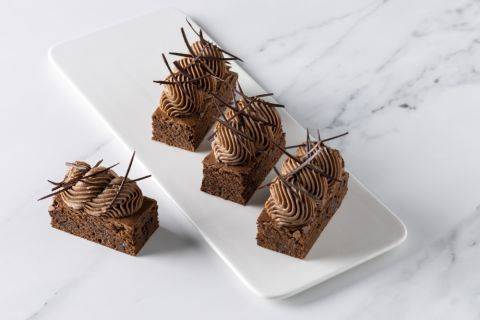Dairy-Free Ice Creams are Growing in Popularity
Dairy-Free Ice Creams are Growing in Popularity

The market for vegan ice cream options has grown exponentially in the past few years. According to Confectionary News, “The Global Vegan Ice Cream market is poised to grow by €1.48 billion from 2023 to 2026.”
In Germany, for example, the value of the category went from €75.0 million in 2020 to €81.0 million in 2021 and reached €88.8 million in 2022, and it continues to grow!
On a smaller scale, trendy ice cream shops devoted to or at least offering plant-based options are popping up and doing a brisk business. A tour of supermarket ice cream displays shows that even traditional ice cream producers are getting into the game and competing with artisanal brands for shoppers’ attention with flavours that range from solidly traditional to wildly experimental.

Customers won’t compromise on flavor and texture
While most consumers are eager to make healthier choices and are concerned about the planet's health, taste and texture are still the highest priority. In a survey of over 1,000 U.S. consumers, Mintel found that nearly a third expect "equal indulgence from plant-based ice cream as dairy ice cream." In another survey (also conducted by Mintel), over 70% stated that flavour is the most important attribute of ice cream.
Historically, vegan ice creams and sweets have suffered from odd flavours and unappealing textures, so much so that many big ice cream brands market their vegan flavours as "dairy-free" to avoid any negative associations with sub-par products and to prevent consumers from forming an opinion about the ice cream before they've even tried it, according to the Plant-Based Food Association. At the same time, Food Navigator reports that 65% of consumers say they see plant-based dairy products as an opportunity to try something new and note that they would be more willing to try plant-based ice creams if more options were available.
While customers' interest in vegan frozen treats is undeniable, the pressure to create products as good as traditional dairy ice creams is substantial. Coupled with the particular ingredient complexities of ice cream, creating plant-based versions of customer favourites can be somewhat daunting. To get you started, we're helping you explore common ingredients in plant-based and conventional ice creams and their roles. With this knowledge, you'll be better able to craft your own recipes or better understand the ready-made products available to you.

Vegan vs Plant-Based vs Dairy-Free. What's the Difference?
Vegan
In foods, a vegan claim means no ingredients of animal origin are used. That means no eggs, dairy, meat, or derivatives such as gelatin. It is important to note that "vegan" does not exclude traces of ingredients from animal sources inside the product. The exact amount allowed depends on local legislation.
Plant-Based
In foods, a plant-based claim means exactly the same as a vegan claim: no ingredients from animal origins are used; only plant-derived ingredients are used. Similarly, there is currently no strict legislation on plant-based claims.
Dairy-Free
Dairy-free is different from the first two claims. First, dairy-free is the strictest standard in the market when it comes to guaranteeing the absence of dairy in your recipes or products. No detectable traces of dairy whatsoever are allowed. Dairy-free products must be made in a segregated facility where no dairy ingredients can enter, be stored, or be processed.
* Information from the Callebaut NXT Education Guide

3 Tips to keep in mind for creating vegan ice cream
- A good recipe is critical.
Simply swapping plant-based dairy in an egg-free ice cream recipe is unlikely to produce a desirable product.
- Specific and sometimes unusual ingredients will be crucial to your success.
Stabilizers, emulsifiers, and other ingredients your customers may not be familiar with are often necessities for creating frozen products with a creamy, smooth texture. Many come from natural sources despite unfamiliar names.
- Think outside the coconut.
The ubiquitousness of this flavour is wearing thin for even devoted vegan coconut fans. Instead, look to oat milk for its natural creaminess or try pureeing soaked cashews to contribute a cream-like consistency.
Pro-tip: For conventional ice cream, it’s essential to transfer the product to a blast freezer immediately after processing for best texture. This rapid freezing may be even more important for vegan ice cream to stabilize water activity.

Looking for a source of reliable vegan recipes?
Vegan recipes using NXT, including Marike van Beurden’s incredible M_lk Chocolate Ice Cream, can be found in the NXT recipe book.

Conventional Ingredients:
Milk and Cream
Conventional dairy products contribute fat, protein, sugars, and salt, some with particular qualities not found in plant-based dairy.
• Protein helps thicken the final product and can help delay melting.
• Fat contributes to overall texture, specifically softness, body, and creaminess. Fat is also crucial in creating overrun.
In fact, according to Cesar Vega in Toothache Magazine, fat needs to be over 8% of the total recipe to achieve an overrun above 30%, and 40-50% of this fat should be the type that is solid at room temperature, so fats like butter, coconut oil, cocoa butter, and palm oil (check for a sustainable source) are good options.
Low-fat ice creams will require the addition of emulsifiers to achieve the expected texture.
• Conventional dairy naturally contains a small amount of salt, so it’s important to increase the salt level slightly in vegan recipes to achieve a good balance of flavours.
• Milk solids from dairy or added separately contribute lactose and protein.
Egg Yolks
While egg-free ice creams are common, it is good to note that egg yolks contribute fat and emulsifying properties.
Sugars
Sugars such as sucrose, glucose, or dextrose control freezing temperature, improve texture, and help prevent crystallisation.
Most sugars used in ice cream are already vegan. Be aware that substituting products like agave nectar or rice syrup can affect the flavour and texture of your end product and require careful consideration and possibly recipe reformulation to achieve results similar to those achieved with conventional sugars.

Sorbet for the Win!
Find a creamy, dreamy, vegan chocolate sorbet in the Cacao Alphabet from Cacao Barry.

Stabiliers, Emulsifiers, and Inulin
Ingredients like stabilizers and emulsifiers get a bad rap, but many are derived from natural sources and are safe to use in small amounts. Moreover, to achieve the flavour and texture your customers are used to from conventional ice creams, it can be necessary to use supplemental ingredients that will perform the functions of the now-missing dairy ingredients like fat and protein.
Stabilizers help incorporate air, improve texture, improve freezing stability, and prevent melting. Some common ones (seen in plant-based and conventional frozen products) are alginates, agar, carrageenan, guar gum, and xanthan gum.
Emulsifiers help with fat dispersion, air incorporation, and smooth texture and can help increase melting temperature. Lecithin, mono- and diglycerides, sugar esters, and glycerin are used in many frozen products.
A commercial ice cream stabilizer will often use more than one of the ingredients listed above since each has its own unique qualities, and many work better when combined with other stabilizers and emulsifiers.
A closer look at Inulin:
This fibre derived from chicory and Jerusalem artichokes contributes a creamy texture and luscious mouthfeel, usually achieved only with conventional dairy products.
Inulin is the new darling of vegan preparations, helping many chefs give their plant-based creations a creaminess previously impossible without dairy.

With customers clamouring for dairy-free ice cream options, the pressure is on to offer incredible frozen treats everyone can enjoy. Whether you develop your own recipes, use formulas already created for you, or purchase dairy-free mixes or ready-made products, knowing the function of different ice cream ingredients will allow you to be better informed about what you're serving and communicate with your customers.
Sources:
- "The Secrets of Ice Cream" by Angelo Corvitto
- "The Vegan Pastry Bible" by Toni Rodríguez
- "Adapt: A Unique Pastry Concept" by Richard Hawke
- "Ice Cream: It's All About Collisions" by Cesar Vega and Andrés Lara, Toothache Magazine Issue #2
- "Plant-based ice cream market grows as formulation challenges persist" Food Navigator 6/7/2023
- "Get the Scoop on Plant-Based Ice Cream: The Latest Retail Sales Data and Consumer Insight" Plant-Based Food Association 6/14/2023
- "Vegan ice cream on the rise with growth of private label, start-ups and new products from established brands " Confectionery News 1/12/2023
- Special thanks to Chocolate Academy™ UK Chef Clare England





Comments